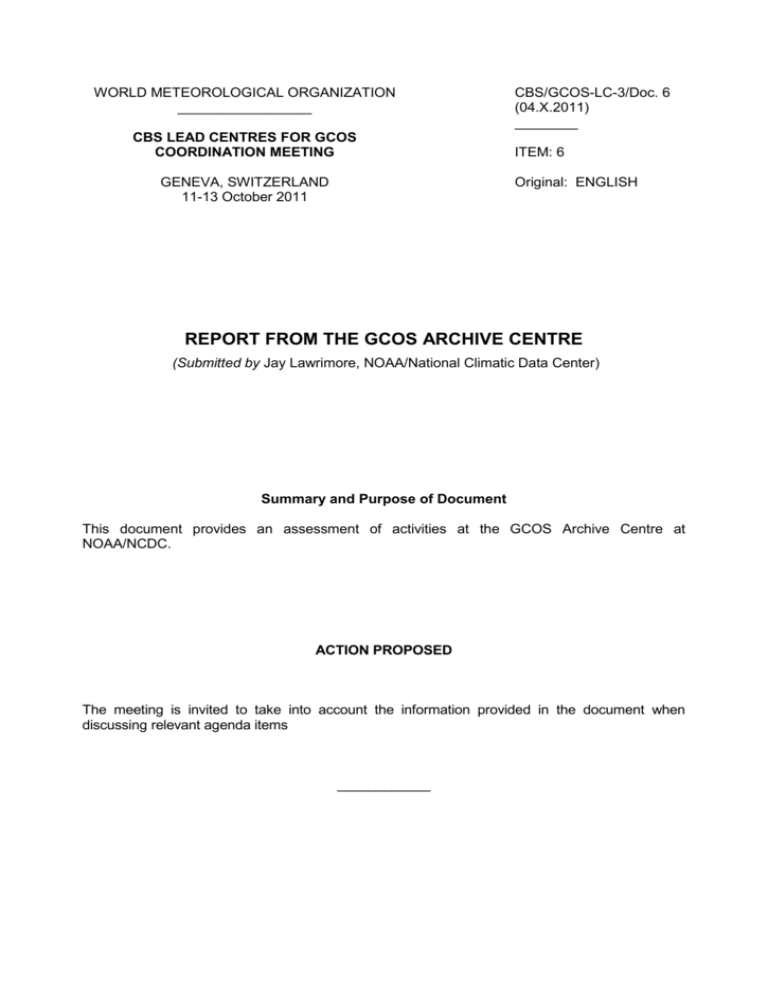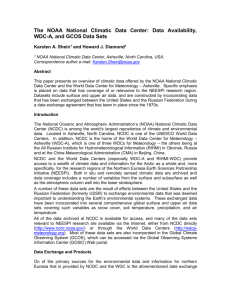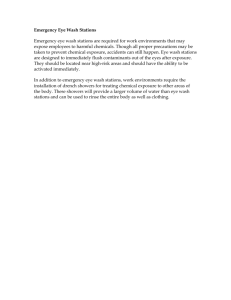Report from GCOS Archive Center
advertisement

WORLD METEOROLOGICAL ORGANIZATION _________________ CBS LEAD CENTRES FOR GCOS COORDINATION MEETING GENEVA, SWITZERLAND 11-13 October 2011 CBS/GCOS-LC-3/Doc. 6 (04.X.2011) ________ ITEM: 6 Original: ENGLISH REPORT FROM THE GCOS ARCHIVE CENTRE (Submitted by Jay Lawrimore, NOAA/National Climatic Data Center) Summary and Purpose of Document This document provides an assessment of activities at the GCOS Archive Centre at NOAA/NCDC. ACTION PROPOSED The meeting is invited to take into account the information provided in the document when discussing relevant agenda items ____________ CBS/GCOS-LC-3/Doc. 6, p. 2 GCOS Archive/Analysis Centre Report 1. The GSN daily database is managed as a subset of the Global Historical Climatology Network-Daily (GHCN-D) data set (http://www.ncdc.noaa.gov/oa/climate/ghcn-daily). In the past two years NCDC continued to expand its collection of global summary of the day data as part of its development of GHCN-D. As part of an agreement with the Australia Bureau of Meteorology, historical and current observations for more than 1,500 stations with temperature and more than 17,000 for precipitation have been added. Data for stations still operating are added during routine update cycles each month. More than 10,000 stations also were added and are updated daily from the US Community Collaborative Rain, Hail, and Snow Network (CoCoRaHS). The total number of stations in GHCN-D has now surpassed 75,000. Approximately two-thirds of these are precipitation only stations. For ease of access, a separate directory of GSN station files is maintained at ftp://ftp.ncdc.noaa.gov/pub/data/ghcn/daily/gsn. 2. Updates of daily data also continue to be provided regularly by Uzbekistan, Iran, Cyprus, Canada, and the United States. The NMS in Uzbekistan consistently provides data within the first two to five days each month, and the NMS of Cyprus provides data for Larnaca on a periodic basis via e-mail. Data from the U.S. and Canada are received via various mechanisms including ftp and web services. 3. A mechanism to establish wider ongoing updates has been initiated with the European Climate Assessment activity led by KNMI. This program provides monthly updates of daily observations for stations throughout Europe, parts of North Africa, and the Middle East. The addition of these stations to GHCN-D in the coming months will add hundreds of new stations with historical and current observations. 4. Other countries for which data were provided at one time require NCDC to reinitiate contact in order to continue data collection activities. NCDC prefers to establish regular data updates of full period of record datasets through ftp or web services to ensure the most consistent and complete historical and current data. 5. Monthly CLIMAT messages serve as the basis for operational climate monitoring activities and are used to update NCDC’s GHCN-Monthly dataset. Since the previous report of the Archive Center, a new version of GHCN-M (version 3.0.0) was completed and released. This provided the opportunity to fill in missing CLIMAT observations from the past 20 years and to include data from the 1991-2000 World Weather Records. This increased the number of available station data in some years by more than 15% as shown in the figure below. However, there remains no consistency between GHCN-Monthly and GHCN-Daily datasets. Efforts are now underway to develop version 4.0.0 of GHCN-M that will include a merge of the two GHCN datasets. CBS/GCOS-LC-3/Doc. 6, p. 3 Figure 2. Number of stations in GHCN-Monthly version 3.0.0 (solid line) and the previous version from 1900 to 2010. The addition of CLIMAT observations and World Weather Records data improved station coverage since 1990. The larger increase since 2006 is primarily due to an increase in the number of stations in the U.S. unrelated to CLIMAT. 6. A new international effort initiated in September 2010 and led by NCDC, the UK Met Office, and other international partners has the potential to greatly benefit efforts to improve global collections of surface observations. Initially focusing solely on temperature observations, the International Surface Temperature Initiative aims to develop a comprehensive global repository of land surface observations that are spatially and temporally complete, fully traceable from the point of observation, freely available, easily accessible, and with quantified uncertainties. Of initial priority is the establishment of a Databank of land surface temperature existing in various “Stages” from the paper record (zero), native format (one), common format (two), to a merged dataset (three). There also will be quality controlled (four) and bias corrected (five) data. Figure 3. Diagram of the land surface databank structure and its relation to the benchmark analogs of Stage 5. CBS/GCOS-LC-3/Doc. 6, p. 4 7. Contributions to the Databank have already begun and include new data sources from Brazil, Uruguay, the Netherlands, Japan, Spain, Antarctica, and many other countries. Data provided by NMSs in their native format are considered Stage 1. As part of initial processing they are converted to a common format and have data provenance tracking flags added to each data value. These flags provide traceability back to the original source and help guarantee data authenticity, integrity, and quality. The flags provide information such as: Original data provider for the Stage 0 and Stage 1 data Type of data provided (raw, quality controlled, bias corrected) Mode of calculation (e.g., original observation, from sub-daily data) Mode of digitization (e.g., Keyed by a named project, auto collected) Mode of transmission (e.g., FTP, NMHS Web Service, GTS, Mail, E-mail) *New data provenance tracking flags can be added as needed 8. The Databank has been established at two sites, providing data in Stage 1 and Stage 2 formats at ftp://ftp.ncdc.noaa.gov/pub/data/globaldatabank/ and ftp://ftp.meteo.ru/pub/data/globaldatabank/ . 9. The Steering Committee of the International Surface Temperature Initiative identified the need for sharing of climate quality daily summaries across the GTS. Currently the only transmission mechanism involves the use of Synoptic messages. This is insufficient for ensuring climate quality daily data are exchanged on a consistent and reliable basis. Actions should be encouraged within the WMO process to establish daily climate messages similar to existing monthly CLIMAT messages. 10. Metadata: NCDC can accept, as a minimum, photographs of station siting, as well as information regarding the type of instrumentation and the timing of station location and instrument changes. Metadata for stations outside the U.S. are contained primarily in ASCII flat files of the Global Historical Climatology Network-Monthly and -Daily datasets and the newly established International Surface Temperature Databank. Little metadata for stations outside the U.S. reside in NCDC’s Oracle-based metadata information systems. Given the necessary resources, NCDC could develop the capacity to store, manage, and provide access to new sources of metadata from the international community. This would likely be provided in the form of web services. Some potential options to consider: a. Photographs of present conditions, coordinates, station contacts, instrument type, etc. b. General description of surroundings (in addition to option (a)) i. Assign a code of 0-9 (listed below) which best describes the current predominant land use within circles around each station at radii of 100 m, 1 km, and 10 km. Examples of codes used by NCDC in describing the surroundings of stations are included below. More than one code could be used if necessary to describe several predominant characteristics within each circle. The intent should be to code the predominant types of land use; not all types. 0. UNKNOWN 1. NON-VEGETATED (barren, desert) 2. COASTAL OR ISLAND 3. FOREST CBS/GCOS-LC-3/Doc. 6, p. 5 4. 5. 6. 7. 8. 9. OPEN FARMLAND, GRASSLAND OR TUNDRA SMALL TOWN, LESS THAN 1000 POPULATION TOWN 1000 TO 10,000 POPULATION CITY AREA WITH BUILDINGS LESS THAN 10 METERS DISTANT* CITY AREA WITH BUILDINGS GREATER THAN 10 METERS DISTANT* AIRPORT *of three stories or greater c. Formal site surveys and ratings such as used by the U.S. Climate Reference Network. An example for temperature classifications is provided below. The best sited stations meet Class 1 criteria. Temperature and Humidity Classification 1 / Classification Number Distance from artificial heating sources and 300+ m reflective surfaces (m) Distances to large bodies of water (m), when location near water is not 300+ m representative of the area Angular height of surrounding vegetation (referenced to eye height) within 100 m 0-5 deg radius (80 % or more coverage is below the angle specified) Slope of cleared & flat ground surface 0-8 deg within 30 m radius 2 3 4 5 240-300 100-240 50-100 0-50 240-300 100-240 50-100 0-50 5-6 deg 6-11 deg 11+ deg * 8-15 deg 15-23 deg 23+ deg * Metadata for the GUAN are provided on the IGRA web site (http://www.ncdc.noaa.gov/oa/climate/igra), which provides examples of metadata event types and classifications. 11. Sub-daily data continue to be added to NCDC’s Integrated Surface Database (ISD). However new efforts as part of the International Surface Temperature Initiative will be needed to identify and develop new sources of historical data. Data rescue efforts that leverage Crowdsourcing capabilities, such as those of Zooniverse and oldweather.org, also will be a necessary part of any international efforts to collect substantial sources of sub-daily digital data.






